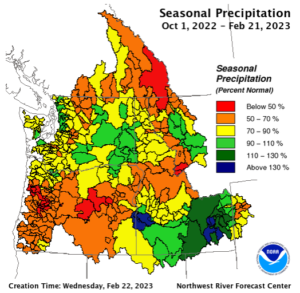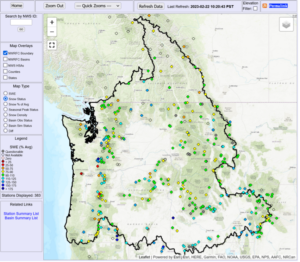After a colder and wetter winter than in recent years, the Columbia Basin is predicted to see slightly above average snowmelt runoff and higher water levels in the coming spring according to Columbia River Inter-Tribal Fish Commission (CRITFC) Hydrologist and Meteorologist Kyle Dittmer.
Dittmer provides an annual forecast for Columbia River tribal fishers and the general public to help anticipate water levels throughout the year.
“Water should be plentiful this year,” says Dittmer. “That means fish, tribal fishers, irrigators, farmers, and cities should expect to see more ease in getting their water needs met.”

Figure 1. Columbia Basin seasonal precipitation. Southern Idaho and eastern Washington received higher-than-normal totals, but central and southern Oregon and the Upper Columbia saw below-normal totals.
The 2023 water year, which began Oct. 1, has had more consistent rain and mountain snowfall compared to recent years. (See Figure 1.) However, this precipitation hasn’t covered the Columbia Basin equally. Southern Idaho and eastern Washington received higher-than-normal totals, but central and southern Oregon and the Upper Columbia saw below-normal totals. Unfortunately, the latter basins are important contributors to the summer water supply.
Though the 2023 Columbia Basin water situation is positive, Confederated Tribes of the Umatilla Indian Reservation (CTUIR) Acting First Foods Policy Program Manager, Althea Wolf, points out that a good year doesn’t erase the more troubling trend predicted for the region.
“The trend for the region generally bends toward lower and warmer water levels, reduced snowpack, and greater variability and unpredictability for the Columbia Basin and surrounding regions,” explains Wolf. “Without being able to accurately predict snowpack, rainfall and spring and summer water levels, accurate forecasts are difficult, and the region has few options to prepare.”
The current La Niña conditions have produced colder than normal temperature with above-average rain and snowfall in the Pacific Northwest. This colder winter means the spring snowmelt runoff will be moderately above average and could be a little late due to colder than normal mountain temperatures and the region will be spared any widespread rain on snow events that melts the snowpack quickly.
“Rain on snow events create emergency conditions and don’t leave adequate time for the snow to melt slowly and filter as it enters the soil and surrounding water,” warns Wolf.

Figure 2. Seasonal snowpack through 2/22/2023. The Washington Cascades and Snake River-Plain basins are looking good. Current snow level is at 1000 feet. The region is just past the half-way point in the seasonal accumulation of PNW snowpack.
The region is just past the half-way point in the seasonal snowpack accumulation. (See Figure 2.) Snowpack, along with monthly and seasonal precipitation and current river flow, are used to calculate the seasonal water supply forecast. The Corps of Engineers, BPA, and Bureau of Reclamation use this forecast to determine how much water to release for power, irrigation, and fish. Different agencies have different predictions for this forecast.
Dittmer’s latest forecast is for the Columbia River at The Dalles, 120% of normal, during the April to July runoff period. The National Oceanic and Atmospheric Administration forecast is only 82% of normal.

Figure 3. Drought monitor for the western US. Much of central Oregon remains in extreme or exceptional drought.
Even without major rain on snow events, there is still concern from the multi-year drought. (See figure 3.) “As long as the snow melts slowly, dry soils will absorb the water like a sponge,” explains Dittmer. “This means that the expected tributary river runoff may be a little lower than expected in some areas as the soils are replenished.”
In addition to the potential for some much-needed drought relief in some areas, this year’s forecast also appears to be good news for juvenile salmon.
“Migrating juvenile salmon will have the water they need,” says Dittmer. “There should be good water supply all the way up to the Hells Canyon Complex. That’s a bit unusual, but it will work in the fish’s favor, especially the Lower Snake River system.”
The ocean conditions this year’s fish will encounter along the Pacific Northwest and Alaska coastlines are also more favorable for their survival right now due to enhanced coastal upwelling from the deep ocean that will provide them with plenty of food.
While both Dittmer and Wolf expressed cautious optimism for this year, Wolf closed with a reminder that next year might be completely different: “Years are going to look so different one to the next as we move in this warmer trajectory. It will be difficult to anticipate how we should prepare.”
